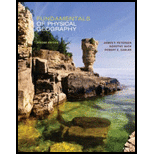
(a)
The water vapor capacity of air at
(a)
Answer to Problem 1PA
The water vapor capacity of air at
Explanation of Solution
Air holds a certain amount of water vapor at any given temperature. When air holds all the water vapor that it can, it is said to be in its saturated condition and to have reached its moisture capacity. The water vapor capacity or moisture capacity of air is the maximum amount of water vapor that the air can store at a given temperature.
Figure 5.6 in the textbook shows a graph of the maximum amount of water vapor that can be contained in a cubic meter of air over a wide range of temperatures. According to the graph, the water vapor capacity of air at
(b)
The relative humidity of an air parcel if the temperature is given as
(b)
Answer to Problem 1PA
The relative humidity of an air parcel if the temperature is given as
Explanation of Solution
Relative humidity is the ratio of the amount of water vapor of the given air at that temperature and the maximum amount of water vapor that the air can hold at that temperature. It is expressed in percentages.
The temperature of the air parcel is given as
The formula to calculate relative humidity is given below:
Substitute the values of actual water vapor content in air as 20.5 grams per cubic meter and maximum water vapor that air can hold as 30 grams per cubic meter.
(c)
The actual water vapor content of the air with 60% of relative humidity at 5 degrees centigrade and the new relative humidity if the air is heated to 20 degrees centigrade without increase in water vapor content.
The actual water vapor content of the air with 60% of relative humidity at 5 degrees centigrade is 4.8 gram per cubic meter and the new relative humidity if the air is heated to 20 degrees centigrade without increase in water vapor content is 26.6%.
(c)
Explanation of Solution
Relative humidity is the ratio of the amount of water vapor of the given air at that temperature and the maximum amount of water vapor that the air can hold at that temperature. It is expressed in percentages.
The temperature of the air parcel is given as
The formula for the actual water vapor content is given below:
Substitute relative humidity as 60% and maximum water vapor that air can hold as 8 grams per cubic meter.
If the temperature of air parcel is raised to
The formula for the relative humidity is given below:
Substitute the maximum water vapor that the air can hold as 18 grams per cubic meter and the actual water vapor content in air as 4.8 grams per cubic meter.
Want to see more full solutions like this?
Chapter 5 Solutions
Fundamentals of Physical Geography
 Applications and Investigations in Earth Science ...Earth ScienceISBN:9780134746241Author:Edward J. Tarbuck, Frederick K. Lutgens, Dennis G. TasaPublisher:PEARSON
Applications and Investigations in Earth Science ...Earth ScienceISBN:9780134746241Author:Edward J. Tarbuck, Frederick K. Lutgens, Dennis G. TasaPublisher:PEARSON Exercises for Weather & Climate (9th Edition)Earth ScienceISBN:9780134041360Author:Greg CarbonePublisher:PEARSON
Exercises for Weather & Climate (9th Edition)Earth ScienceISBN:9780134041360Author:Greg CarbonePublisher:PEARSON Environmental ScienceEarth ScienceISBN:9781260153125Author:William P Cunningham Prof., Mary Ann Cunningham ProfessorPublisher:McGraw-Hill Education
Environmental ScienceEarth ScienceISBN:9781260153125Author:William P Cunningham Prof., Mary Ann Cunningham ProfessorPublisher:McGraw-Hill Education Earth Science (15th Edition)Earth ScienceISBN:9780134543536Author:Edward J. Tarbuck, Frederick K. Lutgens, Dennis G. TasaPublisher:PEARSON
Earth Science (15th Edition)Earth ScienceISBN:9780134543536Author:Edward J. Tarbuck, Frederick K. Lutgens, Dennis G. TasaPublisher:PEARSON Environmental Science (MindTap Course List)Earth ScienceISBN:9781337569613Author:G. Tyler Miller, Scott SpoolmanPublisher:Cengage Learning
Environmental Science (MindTap Course List)Earth ScienceISBN:9781337569613Author:G. Tyler Miller, Scott SpoolmanPublisher:Cengage Learning Physical GeologyEarth ScienceISBN:9781259916823Author:Plummer, Charles C., CARLSON, Diane H., Hammersley, LisaPublisher:Mcgraw-hill Education,
Physical GeologyEarth ScienceISBN:9781259916823Author:Plummer, Charles C., CARLSON, Diane H., Hammersley, LisaPublisher:Mcgraw-hill Education,





